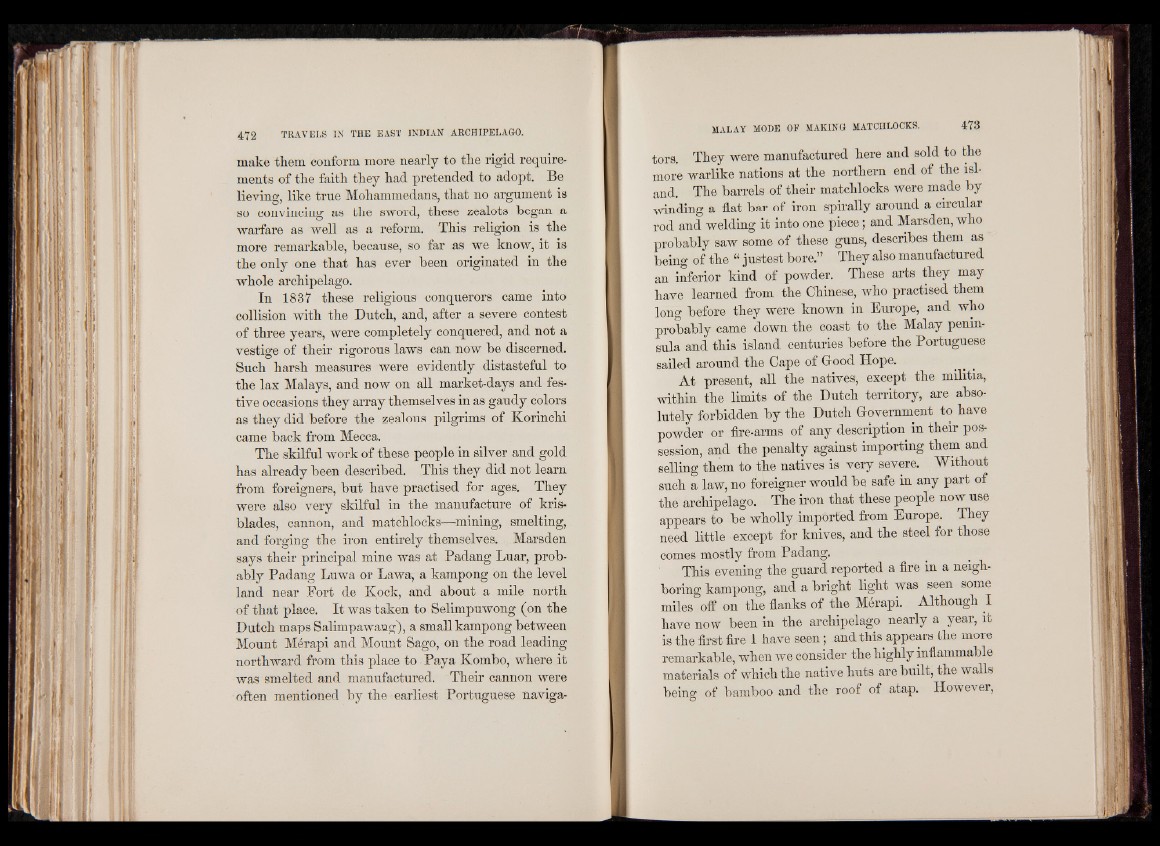
make them conform more nearly to the rigid requirements
of the faith they had pretended to adopt. Be
lieving, like true Mohammedans, that no argument is
so convincing as the sword, these zealots began a
warfare as well as a reform. This religion is the
more remarkable, because, so far as we know, it is
the only one that has ever been originated in the
whole archipelago.
In 1837 these religious conquerors came into
collision with the Dutch, and, after a severe contest
of three years, were completely conquered, and not a
vestige of their rigorous laws can now be discerned.
Such harsh measures were evidently distasteful to
the lax Malays, and now on all market-days and festive
occasions they array themselves in as gaudy colors
as they did before the zealous pilgrims of Korinchi
came back from Mecca.
The skilful work of these people in silver and gold
has already been described. This they did not learn
from foreigners, but have practised for ages. They
were also very skilful in the manufacture of kris-
blades, cannon, and matchlocks—mining, smelting,
and forging the iron entirely themselves. Marsden
says their principal mine was at Padang Luar, probably
Padang Luwa or Lawa, a kampong on the level
land near Fort de Kock, and about a mile north
of that place. It was taken to Selimpuwong (on the
Dutch maps Salimpawang), a small kampong between
Mount Merapi and Mount Sago, on the road leading
northward from this place to Paya Kombo, where it
was smelted and manufactured. Their cannon were
often mentioned by the earliest Portuguese navigators.
They were manufactured here and sold to the
more warlike nations at the northern end of the island.
The barrels of their matchlocks were made by
winding a flat bar of iron spirally around a circular
rod and welding it into one piece; and Marsden, who
probably saw some of these guns, describes them as
being of the “ justest bore.” They also manufactured
an inferior kind of powder. These arts they may
have learned from the Chinese, who practised them
long before they were known in Europe, and who
probably came down the coast to the Malay peninsula
and this island centuries before the Portuguese
sailed around the Cape of Good Hope.
At present, all the natives, except the militia,
within the limits of the Dutch territory, are absolutely
forbidden by the Dutch Government to have
powder or fire-arms of any description in their possession,
and the penalty against importing them and
selling them to the natives is very severe. Without
such a law, no foreigner would be safe in any part of
the archipelago. The iron that these people now use
appears to be wholly imported from Europe. They
need little except for knives, and the steel for those
comes mostly from Padang.
This evening the guard reported a fire in a neighboring
kampong, and a bright light was seen some
miles off on the flanks of the Merapi. Although I
have now been in the archipelago nearly a year, it
is the first fire I have seen; and this appears the more
remarkable, when we consider the highly inflammable
materials of which the native huts are built, the walls
being of bamboo and the roof of atap. However,